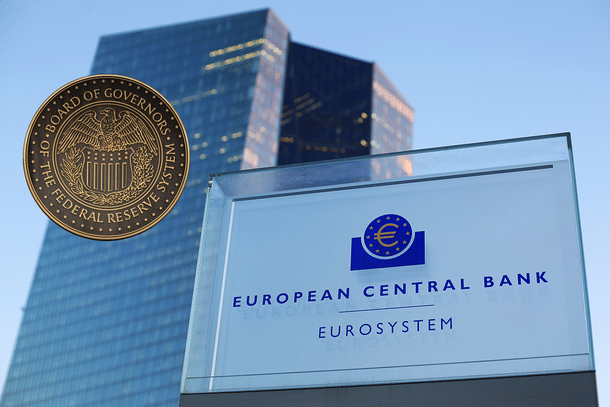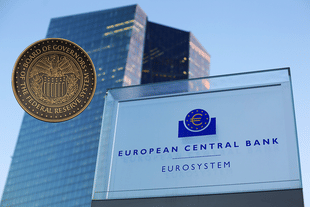World
How US Fed And ECB Have Mismanaged Their Briefs And Landed Everyone In The Ditch
R Jagannathan
Jul 14, 2022, 12:56 PM | Updated 12:56 PM IST
Save & read from anywhere!
Bookmark stories for easy access on any device or the Swarajya app.


Two signals — the highest US consumer inflation rate since 1981 at 9.1 per cent, and the euro reaching parity with the US dollar — tell us how the rich world has got its monetary policy all wrong over the last two decades.
Two months ago, a Bloomberg columnist, Andy Mukherjee, was berating the Reserve Bank of India (RBI) for being behind the curve in raising rates, given high consumer inflation, but while the RBI did its job quickly, it is the US Fed and the European Central Bank (ECB) that are far behind the curve.
Consider just two numbers: at 9.1 per cent, the US real interest rate, given a US Federal Reserve target funds rate of 1.5-1.75 per cent — which gives a negative real interest rate of a whopping 7 per cent and more. The US Fed is not just a wee bit, but whole miles behind the curve.
In Europe, the ECB is doing even more badly, with its key rates either at zero or negative. Though it will raise rates later this month, the fact is eurozone inflation is as high as 8.6 per cent. As opposed to this, the ECB’s key rates for refinancing operations, marginal lending facility and deposit facility have remained unchanged for long at zero, 0.25 per cent and a negative -0.5 per cent respectively. Real interest rates are a mind-boggling -8 per cent and more.
In contrast, the RBI’s repo rate of 4.9 per cent is just over 2 per cent behind the consumer inflation rate of 7 per cent.
Any sane person will conclude that the RBI is managing monetary policy, no doubt, with help from the fiscal side, where duty cuts have helped ease fuel prices, far better than the Western central banks.
The markets actually know this much better than biased market commentators. This is why the euro is sinking against the dollar, for the ECB is light years behind the curve, and given the possibility of a recession, is likely to fall back further in the coming year.
Of course, one can argue that the massive surge in Western inflation rates is the result of the Russia-Ukraine war, but this is a half-truth at best. How Europe and the US responded to the war made more of a difference than just the fact of the war being launched by Vladimir Putin.
Western sanctions, which included draconian decisions to freeze Russia’s dollar reserves and asking Western companies to withdraw from Russia, ensured that the bulk of the costs of the war were loaded on to Europe and the rest of the world, as energy prices shot up everywhere. The US, which is fairly self-sufficient in oil and gas, was sitting pretty, but still managed to let inflation rip. The Europeans, who were dependent on Russian gas and oil, suffered more along with the rest of the world.
Sanctions constitute bad economics, even if they are deemed politically necessary to punish an aggressor. This is not to give Russia a free pass for invading Ukraine, but even here, one can hardly give the West even pass marks in trying to prevent the war, which happened partly because the West refused to accept Russia’s legitimate security concerns over the expansion of NATO right upto its borders.
Western political and economic mismanagement thus stand exposed as hollow.
The second point worth making is that monetary policy is seldom insulated from political pressures. The ECB and the US Fed are as independent as they come, but the proof of this alleged independence should have come from aggressive policy actions long before inflation went out of control. But neither the ECB nor the Fed did much when they could have. So much for independence.
In India, where the RBI Governor had no qualms about talking to the Finance Ministry about its own concerns, was able to get the fiscal side to do its bit to reduce inflation. The Western idea, that independence means the fiscal and monetary sides behaving like they are on separate planets is past its sell-by date. When economies are in trouble, it is dialogue and coordinated action that works best.
If the world economy has landed in the ditch, it's because the US and European Union's fiscal and monetary policies have been so badly mismanaged, that corrective courses are now impacting all economies. When US interest rates are so low in contrast with their inflation rates, investors have no option but to pull out money from economies that are actually doing well (like India), and disrupting their markets. Bad US economics is negatively impacting the economies of the better performing ones.
Western economic theory and practices are now proving to be a millstone around their economies’ necks because commonsense is missing from policy. They are dragging the rest of the world down with them.
Jagannathan is Editorial Director, Swarajya. He tweets at @TheJaggi.





